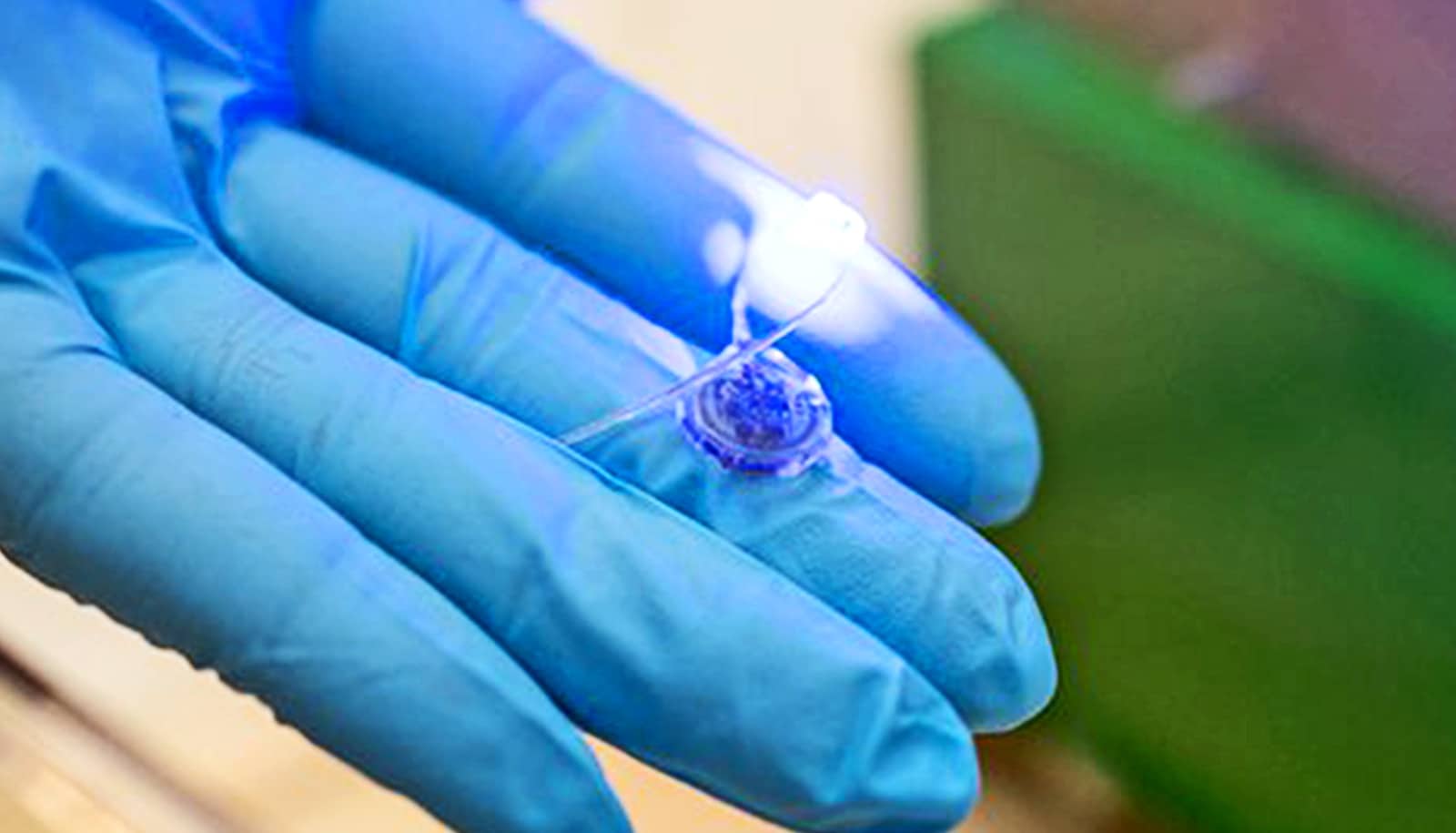
Park’s paddle-shaped device consists of a harvester that contains microchips for wireless communication. The harvester also produces currents to power LEDs inserted near the end of the shaft. (Credit: Matthew Linguist/Texas A&M)
Implant uses light to tell your brain you’re not hungry
A new wireless medical implant stimulates the endings of the vagus nerve, which is responsible for the regulation of food intake.
A new implantable medical device might offer a less invasive method than gastric bypass to help with weight loss, a new study shows.
Gastric bypass surgery is sometimes the last resort for those who struggle with obesity or have serious health-related issues due to their weight. The invasive procedure, which involves making a small stomach pouch and rerouting the digestive tract, can prolong the recovery period for patients.
Researchers say the new centimeter-sized device stimulates the endings of the vagus nerve to provide a feeling of fullness. Unlike other devices that require a power cord, the new wireless device can be controlled externally from a remote radio frequency source.
“We wanted to create a device that not only requires minimal surgery for implantation but also allows us to stimulate specific nerve endings in the stomach,” says Sung II Park, assistant professor in the electrical and computer engineering department at Texas A&M University. “Our device has the potential to do both of these things in the harsh gastric conditions, which, in the future, can be hugely beneficial to people needing dramatic weight-loss surgeries.”
Their findings appear in Nature Communications .
For people with a body mass index greater than 35 or who have at least two obesity-related conditions, surgery offers a path for patients to not only lose the excess weight, but maintain their weight long-term.
In recent years, the vagus nerve has received attention as a target for treating obesity since it provides sensory information about fullness from the stomach lining to the brain. Although there are medical devices that can stimulate the vagus nerve endings and consequently help in curbing hunger, these devices are similar in design to a pacemaker, with wires connected to a current source providing electrical jolts to activate the tips of the nerve.
Park says wireless technology, as well as the application of advanced genetic and optical tools, have the potential to make nerve stimulation devices less cumbersome and more comfortable for the patient.
“Despite the clinical benefit of having a wireless system, no device, as of yet, has the capability to do chronic and durable cell-type specific manipulation of neuron activity inside of any other organ other than the brain,” he says.
To fill this gap, Park and his team first used genetic tools to express genes that respond to light into specific vagus nerve endings in vivo. Then, they designed a tiny, paddle-shaped device and inserted micro LEDs near the tip of its flexible shaft, which was fastened to the stomach.
In the head of the device, called the harvester, they housed microchips needed for the device to wirelessly communicate with an external radio frequency source. The researchers also equipped the harvester to produce tiny currents to power the LEDs. When the radio frequency source was switched on, the researchers showed that the light from the LEDs was effective at suppressing hunger .
The researchers say they were surprised to uncover that the biological machinery coordinating hunger suppression in their experiments was different from conventional wisdom. It is widely accepted that when the stomach is full, it expands and the information about stretch is conveyed to the brain by mechanoreceptors on the vagus nerve.
“Our findings suggest that stimulating the non-stretch receptors, the ones that respond to chemicals in the food, could also give the feeling of satiety even when the stomach was not distended,” Park says.
Looking ahead, he says the current device could also manipulate nerve endings throughout the gastrointestinal tract and other organs, like the intestine, with little or no modifications.
“ Wireless optogenetics and identifying peripheral neural pathways that control appetite and other behaviors are all of great interest to researchers in both the applied and basic fields of study in electronics, material science, and neuroscience,” Park says. “Our novel tool now enables interrogation of neuronal function in the peripheral nervous systems in a way that was impossible with existing approaches.”
Additonal coauthors are from the University of Texas at Dallas and the University of Washington.
This work received support from the X-Grants Program, a NARSARD Young Investigator Award from the Brain and Behavior Research Foundation, the National Science Foundation’s Engineering Research Center for Precise Advanced Technologies and Health Systems (PATHS-UP), the University of Washington Diabetes Research Center, and the National Institutes of Health.
Source: Rachel Rose for Texas A&M University
The post Implant uses light to tell your brain you’re not hungry appeared first on Futurity .
Share this article:
This article uses material from the Futurity article, and is licenced under a CC BY-SA 4.0 International License. Images, videos and audio are available under their respective licenses.
Related Articles:
This spot in the brain is key to feeling full after eating
Feb. 14, 2022 • futurityLow-carb diet coaching boosts health for people with diabetes
Nov. 4, 2019 • futurityLinks/images:
- https://www.futurity.org/bariatric-surgery-weight-loss-1238262-2/
- https://doi.org/10.1038/s41467-020-20421-8
- https://www.futurity.org/vagus-nerve-1335012-2/
- https://www.futurity.org/hunger-receptor-obesity-1736322/
- https://www.futurity.org/optogenetics-superballs-colors-heartbeat-2203542-2/
- https://today.tamu.edu/2021/01/08/tiny-wireless-device-sheds-light-on-combating-obesity/
- https://www.futurity.org/wireless-implant-vagus-nerve-hunger-obesity-2499052-2/
- https://www.futurity.org


